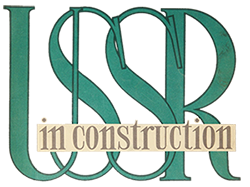About
USSR in Construction is a photographic propaganda journal published in the Soviet Union throughout the years 1930 to 1941, and briefly in 1949. It was published in Russian, French, English, German, and, from 1938, Spanish, and its self-proclaimed purpose was to “reflect in photography the whole scope and variety of the construction work now going on the USSR”. It was an important foreign relations tool and was used to portray a positive image of the developments occurring in the Soviet Union to the rest of the world. The journal informed readers abroad of the rapid construction and industrialization taking place within the Soviet Union and depicted the nation as a leading industrial power.
Before the publication of USSR in Construction, the government utilized other methods of foreign policy. Large exhibitions such as the International Hygienic Exhibition, and the Pressa, an international exhibition of the modern press, advertising, and publishing, were held in Germany until 1933 when Hitler rose to power. The distribution of media such as films, as well as inviting prominent foreign individuals to tour the Soviet Union, was also included as a method of gaining international influence.
The time was right, then, for the conception of USSR in Construction. Founded by writer Maxim Gorky, the magazine employed some of the best writers, playwrights, photographers, and graphic designers of the time, even including some foreigners such as John Heartfield during its early years. The issues were aimed primarily at an international audience, especially western left wing intellectuals and businessmen, and were quite popular during its early publications, including Bernard Shaw, H. G. Wells, John Galsworthy, and Romen Rolland among its subscribers. This audience disappeared, however, after Stalin signed a pact with Hitler in 1939. When the Nazis invaded Russia less than two years later, the magazine quit. An attempt was made to revive it again in 1949, but it failed, and the magazine’s concept, layout, and order was changed and it was renamed The Soviet Union in 1950.
The first issues of USSR in Construction tended to focus upon large state projects, particularly those related to industrialization. The scope of the journal quickly expanded, however, with later issues focusing on different ethnic republics and regions, various building projects, new transportation routes, and themes of daily life such as children, the arts, and athletics, in addition to special political issues.
From a design perspective, USSR in Construction is an example of early 20th century photomontage, and utilizes inserts, fold out pages, and the dynamic use of scale and contrast. The journal used high quality paper and oversize pages measuring 16.5 by 11.5 inches. For special issues, however, the magazine’s creators would get even more elaborate. The issue about the 17th Congress of the Communist Party was wrapped in the pieces of the cloth of balloon “USSR”, which reached a record 60695 feet. In 1934, a gramophone record was included, with stories about experiments with the development and design of the issue. The issues devoted to the Maxim Gorky aircraft, the Tupolev ANT-20, had an aluminum cover. In 1936, in an issue which focused on Georgia, the pictures were partially printed with gold leaf. The method of printing used to print the magazine was rotogravure, a type of intaglio printing process. This method was used to create high quality duotone images, which often fill entire pages. While there are often carefully crafted descriptions accompanying the images, the photographs, layouts, and design are the main attraction.

